NOTEBOOK 11
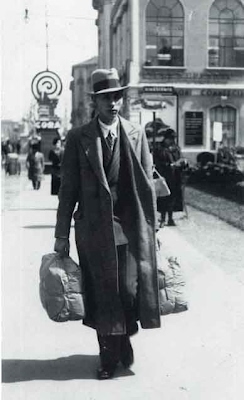
Archimede Seguso in Milan for business. Easter 1935.
PRESENTATION
SUBLIME MATTER
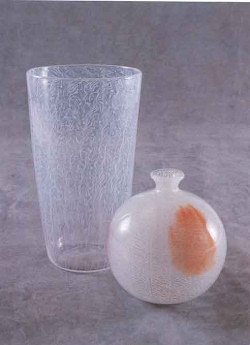
Vase, soft white “lace” and Vase, white “lace” with shaded color, 1953.
In these pages we present Archimede Seguso’s ‘Merletti’: precious, delicate works in glass created during the fifties by the great master from Murano. He introduces the theme of the 11th Edition to friends, collectors and appraisers like this:
“This Edition is a gift to all those who have defined me as the master of ‘Merletti’ which I created in the fifties and which someone said was my best artistic creation. Time alone will tell. For seventy years I’ve had fun in ovens playing with glass, which for me is a sublime material. I’ve given myself completely to it and have received, day after day, all its secrets. Obviously, then, ‘Merletti’ is not the only thing I have created and in all the thousands and thousands of pieces I have always tried to breathe some of my soul into the glass”.
Before going to London for inclusion in a big exhibition, Archimede Seguso’s ‘Merletti’, will be presented in a specially dedicated section of the Mostra dell’Antiquariato in Bolzano. This exhibition is happening from October 19th to the 27th.
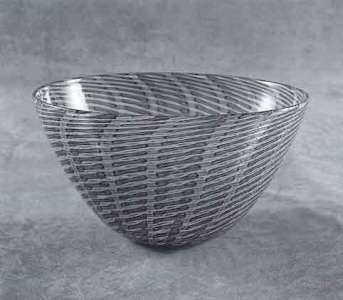
“Merletto” (lace) bowl, 1954.
CULTURAL NEWS
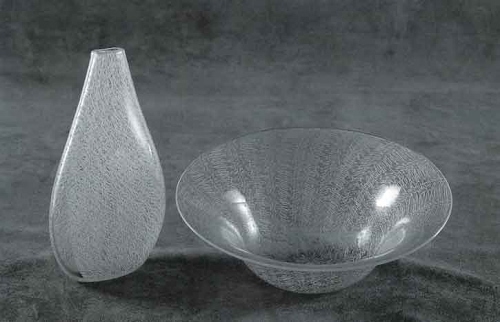
Merletto Vase and Bowl, white, ’50s.
THE LACES OF ARCHIMEDE SEGUSO
Original and complex technical variants of the ancient ‘watermark’ of glass created by the muranese maestro in the 50s. Forty years later, the subtle textures of glass in their timeless splendor are reproposed. There are two techniques that date back to the oldest traditions of glassmaking and which are considered synonymous with the term Venetian glass: they transmit the fragile beauty of Venice’s “palaces” and the sublime elegance of her art to glass. These techniques are the twisted filigree, known as “Zanfirico” since the nineteenth century and the net filigree, that are related, due to similarities in the process and the delicate lace effect created by interwoven glass threads within the thin sides of the vases. The two techniques date from the first half of the sixteenth century and over the centuries have accompanied the vicissitudes of Venetian glassmakers who taught them to colleagues in other countries, while maintaining their primacy.
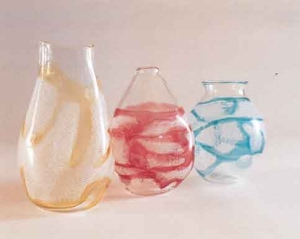
Vases wth large irregular lace weaves, 1952.
In the latter half of the nineteenth century, English writers and collectors, the first to rediscover the artistic quality of Venetian glass coined the suggestive name of “Glass Lace” for this technique. They were struck by the resemblance of the glass filigree to the needle and bobbin lace made by the women of the islands in the Lagoon. The expression “Glass Lace” has long fallen into disuse, but now, in the twentieth century, new, refined filigrees have again rekindled the suggestion of lace to the point that it is now called “Merletto”, the Italian word for “lace”. These are the “Merletti” of Archimede Seguso who developed original and complex variations of the filigree techniques. He has created unusual and delicate esthetic results after four centuries of absolutely repetitivity in the patterns of “reticello” and “zanfirico”, with the glassmakers’ innovations limited to different shapes and color combinations. For centuries filigree was the reign of tradition and consolidated esthetic and technical cannons.

Opaque Bowl with white lace in the interior, ’50s.
Archimede Seguso conceived of his “Merletti” during the fertile years immediately following World War II. He had left the firm of Seguso Vetri d’Arte which he had established with others and opened his own company, Vetreria Archimede Seguso. His fame as an artist and master glassmaker was already established thanks to the extraordinary pieces he had been making since the early ‘thirties. His works from this period, hot-molded sculptures and “soft”, thick sided vases were marked by the plastic solidity of the Twentieth Century style, and thus were diametrically opposed to the delicate, almost impalpable weave of the “Merletti”. Without abandoning plastic research, which remained a fundamental creative theme for Archimede Seguso, the master turned, in parallel to the recovery, in a totally modern key of the traditional techniques of thin blown glass that had been neglected in the first half of the century. The return to lightness, lively polychrome, filigrees, “murrine”, and “incalmi” were a common denominator for the craftsmen of Murano committed to the postwar renewal. If, thanks to traditional techniques, they found shapes and decorations that were in unusual harmony with the most current trends in art and design, Archimede Seguso faced the challenge of a more radical renewal that involved the techniques themselves.
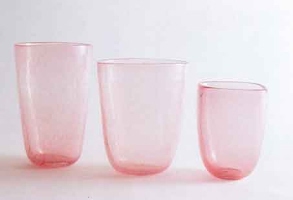
Pink “Merletto” Vases, early ’50s

Vases, in “merletto” and ruby, 1950
Maestro Seguso was engaged on two fronts, the first revealed the desire to apply his skill in plastic modeling of the most current forms. And this gave us essential, small figurative sculptures, and thick-sided vases, softly molded in harmony with the most significant expressions of post-war informal art, in which vague chromatisms also re-echoed. Examples of this period are the “Macchie Ambra e Verdi” and “Pennellati” series of 1952 and 1953, respectively, while other pieces of similar plastic consistency were more classical and symmetrical to satisfy clients with traditional tastes.

Vase and Bowls, black and white pattern, 1958.
The second front was, as we have said, the recovery of the oldest traditional Venetian techniques, and filigree in particular. If, for the pieces of plastic force he developed the theme of the ‘thirties, for the research on old techniques that had been neglected in that decade, he turned back to experiences of the early years of his career as a glassmaker alongside his father and other talented craftsmen from the classic school. The master’s first significant pieces in filigree date from 1950 and they are perfectly “woven” meshes of unusual colors, such as red and coral. Archimede Seguso’s great innovation, however, came in 1951 the year of the IX Triennale exhibition in which the Venetians were challenged by skilled glassmakers from Northern Europe, and in 1952, the year of the XXVl Biennale, that dedicated a retrospective exhibition to Venetian glass, two exceptionally important events. In 1951 he made the bowls with big petals of “zanfiric” tubes, the oval vases with wide straight or zigzag bands in bright colors, the “Nastro Richiamato” series characterized by colored bands that go up the sides of the vase diagonally and descend on an opposite diagonal, with gold leaf inlays. Essential and modern in design, they could only be made by a daring process. They were a technical puzzle that fascinated even expert glassmakers. Even the “Merletti” aroused the same astonished admiration: the first ones were made in 1951, but were officially shown at the 1952 Biennale.
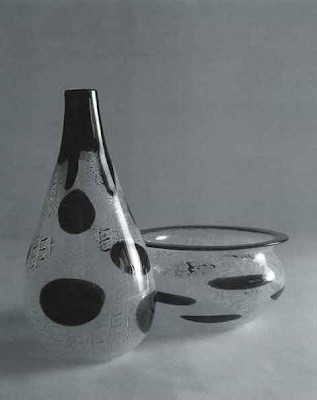
Vase and Bowl, “merletto” with amethyst polka dots, early ’50s.
The thin sides of the “Merletti” were crisscrossed by the very thin weave of glass threads, that, while seemingly uneven were actually delicately harmonious. Of assertive graphic impact – often there was no color at all – the abstract weaves of the “Merletti” seem to separate from the glass sides, similar to the lace made with using a needle by the island lacemakers. Some of the “Merletti” were essentially symmetrical, but the showcases at the 1952 Biennale contained pieces that were unevenly blown, almost twisted. The close weave of some of the “Merletti” was broken by areas or “windows” of pure glass, framed by narrow, restless threads of dark glass. This daring move, so unexpected in a master educated to the element of harmony of shape and the absolute perfection of vitreous fabric, could only be explained by conscious or purely emotional adherence to the language of abstract art of that decade, “Spatialism”, in particular, that was so alive in the Venetian environments.

Three pieces in glass with diagonal pattern, 1951.
Other “Merletti” were created in a patchwork with colored glass “stitches”. The vases in the series “Fantasie a Nastro” also known as “Doppio Merletto”, presented at the same 1952 edition of the Biennale were more lavish and complex with greater consistency in the glass structure. Created mainly in amethyst and clear glass, they were often inflamed by bands of coral glass. Still in 1952 he created the delicate blown pieces of ivory glass with gold leaf and the lozenge-shaped vases with the luminous glow of antique jade. For the entire decade, the Biennale and Triennale exhibitions marked the development of Archimede Seguso’s research and studies.
The two events coincided in 1954, and in Venice and Milan the master presented many novelties, including variations of the “Merletti”, with large, colored circular spots and a “puntinato” decoration created with different techniques. Alongside of the these the “Composizione Lattimo” with winding tubes, ground to the right thickness, the “Festoni” blown pieces with parallel, rather than radial “zanfiric” tubes, and the “Spiraline” demi-filigree blown pieces, with zanfiric tubes added during the second part of the process.
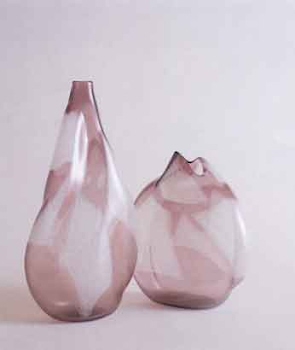
Vases with large irregular “merletto” weaves, 1952.

Vases in “merletto puntiforme” (lace stiching), ’50s.
The molded vases with shaded areas in green, coral, amethyst with goldleaf were made at the same time as these delicate innovations in the filigree technique. In 1955 Archimede Seguso developed yet another variation of the “Merletti”. This time they were radial lobes cut from the bottom of the vase, even in unusual colors such as yellow, acid green, or coral, in thick, blown pieces. The lovely, almost futuristic series “Etere” consisted of classic shapes combined with solid glass elements with submerged spirals of mesh.
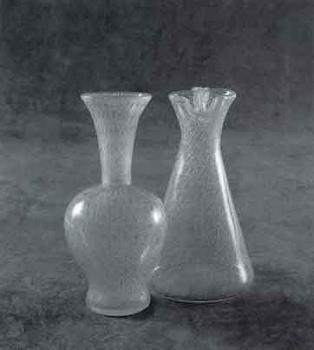
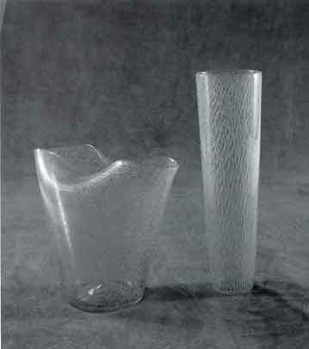
Vases in “merletto puntiforme” (lace stiching), ’50s.
From 1955-56 Archimede Seguso was the spokesman for a new trend in Venetian glass, saturated with complex decorations and lively polychromes. He proposed soft tones and translucent material. More and more frequently, however, his imagination carried him back to the filigree. The most important collections are the delicate “Piume” (1956), the powerful patterns of “Bianconere” (1958) and a few, very linear blown items that reflected the absolute chromatic and formal rigor of the ‘sixties and early ‘seventies, “Fili Continui”, “Filigrane Stellate” “Spinati” and “Petali”. In 1989, at the age of eighty, without having abandoned his career, the master glassmaker, Archimede Seguso decided to commemorate the occasion by reopening the series of delicate glass weaves, and picking up the “Merletti” theme he had developed four decades earlier. Then came the 1991 retrospective exhibit, in the Palazzo Ducale, in his honor, where the visitors were able to admire the intricate compositions of the “Riflessi” (1989) and the “Rete” vases (1991).
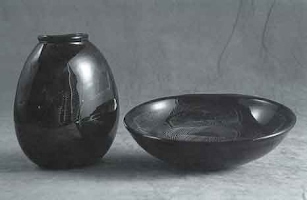
Vases with large irregular weaves of “merletto”, 1952.
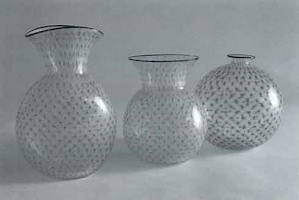
Vases in “merletto puntiforme” (lace stiching), ’50s.
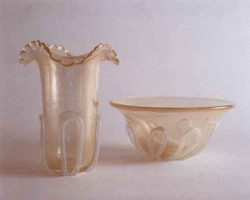
Vase and Bowl “petal” and filigree, 1951.
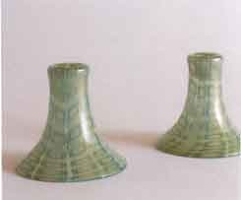
Candleholders lozenges, 1952.
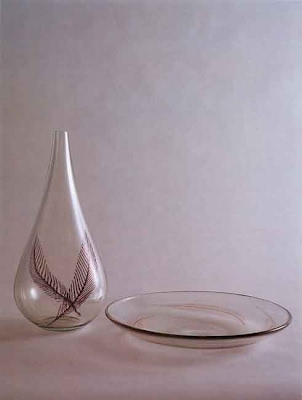
Vase and Plate with feathers, 1956.
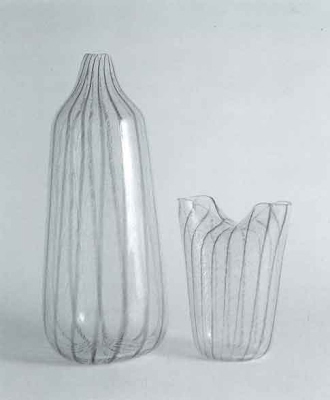
Vases “merletto” with vertical amethyst threads, 1954.

Vase yellow “merletto” , ’50s.
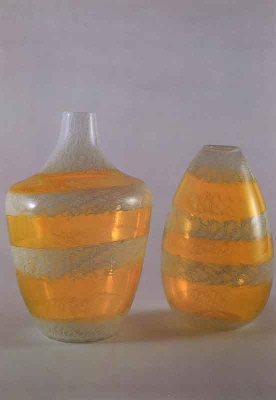
Vases with lace and yellow bands , ’50s.
